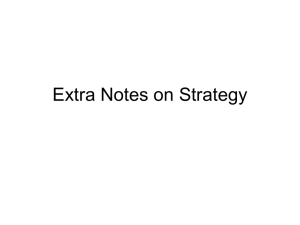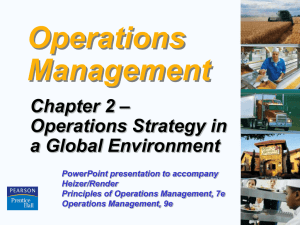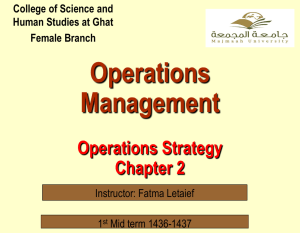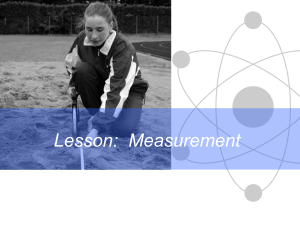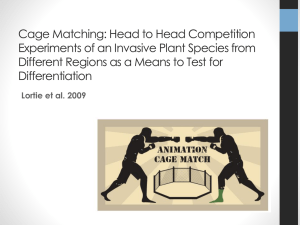3 OM Strategy
advertisement
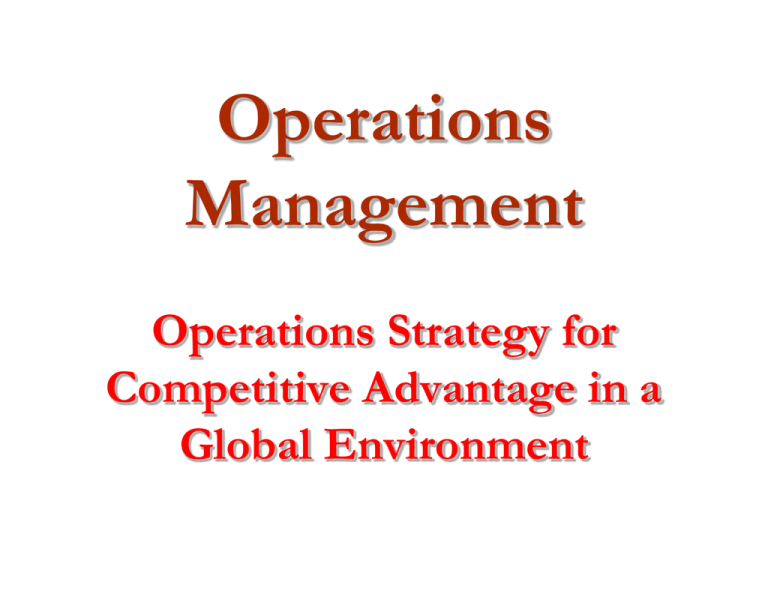
Operations Management Operations Strategy for Competitive Advantage in a Global Environment Reasons to Globalize Reduce costs (labor, taxes, tariffs) Improve supply chain Provide better goods and services HLL’s Wheel in response to Nirma Understand markets Learn to improve operations Attract and retain global talent Vision and Mission Vision – The ultimate result of action What an org. would like to happen as a result of the action that it does. Mission – What an org. does, its action. Provides boundaries & focus More functional in nature dealing with pricing, quality, market place and other items of the value chain Vision and Mission of a hospital To make the denizens of kathmandu healthier To provide a healing environment with family-cantered care with compassion, comfort and respect with best possible medical facilities available. Mission/Strategy Strategy - how you are going to get there; the action plan to achieve the mission The answer to the third intrinsic question: Where are we? Where do we want to be? How to achieve? Mission of OM Departments Product Design: To Design products with superb quality and inherent customer value. Quality: To be consistent with quality in every single aspect of production, right from design, procurement, production etc. Process Design: To determine and design production process compatible with low cost, high quality product. Continued Location selection: To locate, design, efficient and economical facilities that will yield high values to the company. Layout: To achieve production effectiveness and efficiency while supporting a high quality of work. Human Resources: To provide a good quality of work atmosphere, well designed, safe rewarding jobs, stable employment, equitable pay in exchange for outstanding individual contribution from employees at all levels. Continued Supply Chain: To collaborate with suppliers to develop innovative products from stable, efficient and effective sources of supply. Inventory: To achieve low investments in inventory consistent with high facility utilizations. Maintenance: To achieve high utilization of facilities and equipment by effective preventive maintenance and prompt repair of facilities and equipment Strategies & Competitive Advantage Ability of the firm to outperform its industry i.e. to earn a high rate of profit than the industry norm Competitive advantage: The creation of a unique advantage over others To achieve a competitive advantage, a firm must create more value than its competitors Differentiation Cost leadership Quick response Competing on Differentiation Create unique bundles of products/services that will be highly valued by customers Differentiation should be thought of going beyond the physical characteristics and service attributes to encompass everything about the product or service that will influence the potential customer. Experience Differentiation: selling experience Eg.; Disney does this where people get immersed surrounded by a dynamic visual and sound experience Can encompass everything related to product or service that influences value Broad Product Line Product features Product Services Status Symbol Technical Innovation Competing on Cost Maximize value as defined by customers Does not mean low quality Establishing a low cost position relative to competitors through Optimum utilization of resources Economies of scale Coverage of variable costs and a lesser proportion of fixed costs (Dumping by the Chinese) Competing on Response Including the values related to timely product development and delivery, as well as reliable scheduling and flexible performance. Flexibility – ability to match changes in marketplace. Volumes and Designs changes Reliability – scheduling. Communicated to the customer so that he/she can rely on. Timeliness – design, production, delivery OM’s Contribution to Strategy Operations Decisions Specific Strategy Used Examples Quality Product FLEXIBILITY Sony’s constant innovation of new products HP’s ability to follow the laptop market Process Design Volume Southwest Airlines No-frills service LOW COST Location DELIVERY Pizza Hut’s five-minute guarantee at lunchtime Federal Express’s “absolutely, positively on time” Layout Human Resource Supply Chain Speed Dependability Maintenance Differentiation (Better) QUALITY Motorola’s automotive products ignition systems Spice Nepal’s network Conformance Performance Inventory Scheduling Competitive Advantage IBM’s after-sale service on mainframe computers Fidelity Security’s broad line of mutual funds AFTER-SALE SERVICE BROAD PRODUCT LINE Cost leadership (Cheaper) Response (Faster)
